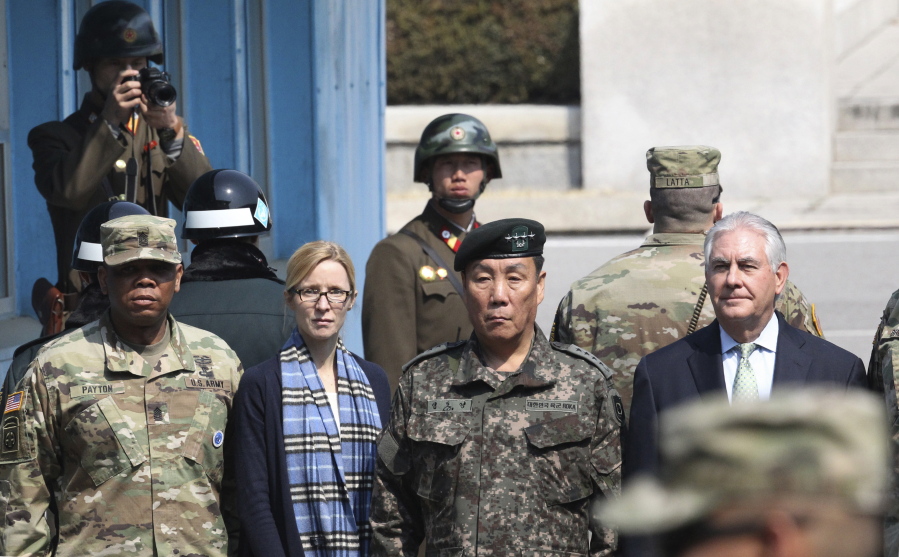SEOUL, South Korea — The United States signaled a tougher strategy toward North Korea on Friday that leaves open the possibility of pre-emptive military action and rejects talks with the communist nation until it gives up its weapons of mass destruction.
“Let me be very clear: the policy of strategic patience has ended,” Secretary of State Rex Tillerson said. “We are exploring a new range of diplomatic, security and economic measures. All options are on the table.”
Tillerson was speaking after visiting the heavily militarized border between the rival Koreas. His comments are likely to displease Beijing, where he travels this weekend. China has been advocating diplomacy to avoid a conflict on the peninsula.
Also Friday, President Donald Trump tweeted: “North Korea is behaving very badly. They have been ‘playing’ the United States for years. China has done little to help!”
Past U.S. administrations have considered military options against North Korea and have publicly said that an attack on the U.S. or its allies would prompt a devastating response.
Tillerson’s comments were unusual, however, as he appeared to be implying, in public, that the U.S. would consider military force as a way of preventing an attack by Pyongyang, and not just as a means of retaliation. It also comes amid a greater sense of urgency about the threat because of North Korea’s rapid progress toward developing the means to strike the U.S. with a nuclear-tipped missile. Risks of military action are high as North Korea could unleash a massive artillery barrage on Seoul in retaliation.
The Trump administration said it is conducting a review of North Korea policy. At a news conference in Seoul, alongside his South Korean counterpart Yun Byung-se, Tillerson said U.S was exploring the new range of diplomatic, security and economic measures and emphasized that Obama administration’s policy of “strategic patience”– that saw tightening of sanctions to try and get North Korea back to negotiations aimed at denuclearization — had ended.
Asked about the possibility of using military force against North Korea, he said, “all of the options are on the table.”
He said the U.S. does not want a military conflict, “but obviously if North Korea takes actions that threaten South Korean forces or our own forces that would be met with (an) appropriate response. If they elevate the threat of their weapons program to a level that we believe requires action that option is on the table.”
Former members of the Clinton administration have said that the U.S. considered a strike on a North Korean nuclear facility in 1994 when it appeared on the brink of producing weapons-grade fissile material and refused U.N. inspections. A diplomatic deal was struck to avert conflict.
Since then, North Korea has violated multiple U.N. Security Council resolutions and has been undeterred by tough international sanctions. The North conducted two nuclear test explosions and 24 ballistic missile tests last year. Last week, after the U.S. and South Korea began annual military drills that the North views as rehearsal for invasion, it test-fired four missiles into seas off Japan.
Central to the U.S. review is China and its role in any bid to persuade Pyongyang to change course. China remains North Korea’s most powerful ally and dominant trading partner. China recently announced it was suspending coal imports that are an important source of revenue for North Korea for the rest of the year in adherence with U.N. sanctions.
Tillerson urged China and other countries to fully implement the sanctions. He criticized China’s opposition to a U.S. missile defense system being deployed in South Korea and accused it of waging “inappropriate and troubling” economic retaliation against the South. China sees the system as a threat to its own security although the U.S. said it is only targeted against North Korea. Tillerson said China should focus on the North Korean threat that makes the deployment necessary.
Tillerson also rejected Beijing’s proposal of halting the U.S.-South Korean military drills in exchange for a nuclear freeze by North Korea. He said the allies had no intention to stand down the exercises that are defensive in nature and conducted transparently, unlike North Korean missile launches.



